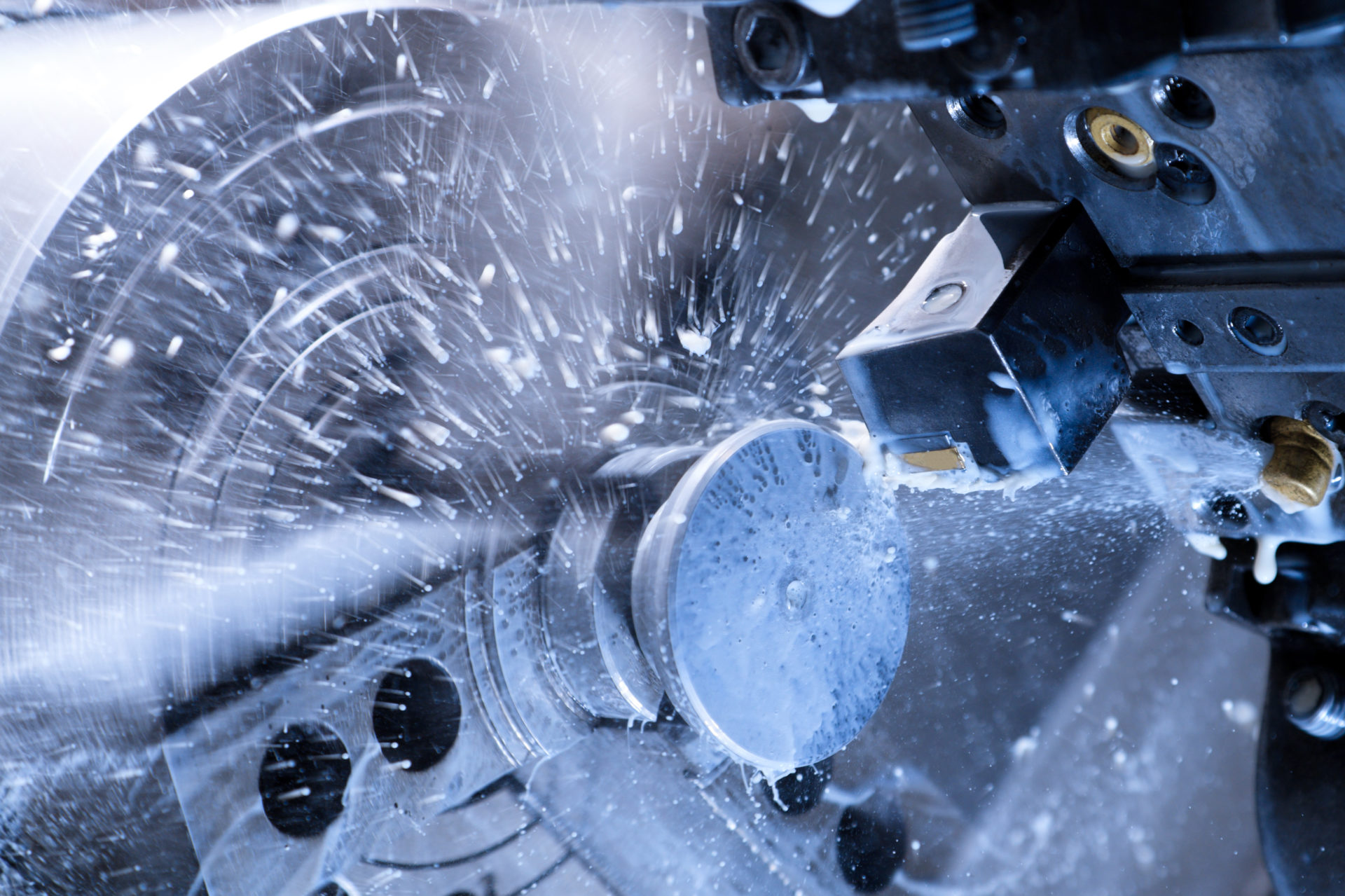Jul 3, 2024
Use Case: How digital twins help save up to 29.5 percent energy in mechanical engineering
A crucial step in manufacturing is machining, which includes turning, milling, drilling, and grinding to shape workpieces. Coolant lubricants are frequently used in this process. However, their use is associated with high energy costs. So high that a consortium of research and industry, including us, has developed measures within the BMWK-funded (BMWK = Federal Ministry for Economic Affairs and Climate Protection) project E-KISS to significantly reduce energy consumption and increase productivity. The project has now concluded, and the results are in: E-KISS achieved a 29.5 percent reduction in electricity usage. The figures are impressive and show the potential of data science combined with retrofit measures.

The Conditions
Machine tools play a central role in industrial manufacturing companies. Sales revenues were 229 billion euros in 2023 [1] (2022: 208 billion euros). Although there are other machining processes, machine tools are still used in industrial manufacturing. They operate with coolant lubricants, which must be available at the right time, in the right place, and in the right dosage to achieve high and consistent quality. Manufacturing with machine tools and coolant lubricants requires additional systems, some of which are legally mandated to ensure occupational safety. All these elements together form a complete system with many components, which is energy-intensive and accounts for an average of 30 to 35 percent of a manufacturing facility's energy demand, sometimes even up to 60 percent [2]. To reduce these high numbers, a consortium of science and industry initiated the research project "E-KISS – Energy Demand-Oriented Operation of Coolant Lubricant Systems" [3]. The project pursues several goals regarding savings. First, the energy demands of the entire system are to be measured, documented, and then reduced through the use of key digital technologies such as cyber-physical production systems and digital twins. E-KISS aims to achieve a reduction in energy demand of approximately 20 to 30 percent compared to the initial situation by the end of the project.
Additionally, the coolant lubricant systems, including the exhaust system, are to be adapted while maintaining or improving process quality, which also leads to energy savings. Almost as a side effect, E-KISS results in a more environmentally friendly lifecycle for workpieces, helping companies achieve their climate protection and sustainability goals.
The project partners of E-KISS include: Technical University of Braunschweig (IWF), Robert Bosch GmbH, ONLINE Industrieelektrik und Anlagentechnik GmbH (Online IAT) – and us, Ascon Systems. The expertise is distributed among production sensor technology (IWF, Online IAT), machine application (Robert Bosch GmbH MWS – subcontract), and the development of digital models and methods (Ascon Systems, IWF).
More Transparency with Contextualized Data Throughout the Product Lifecycle
Plant operators usually have little or no transparency regarding the energy demands of individual components and systems, especially in manufacturing processes where multiple systems work together, as is the case with machining, particularly with coolant lubricants. They are used in grinding to prevent excessive wear and scrap from grinding heat. These processes consume a lot of energy. Efficiency can be improved by using intelligent controls and regulations integrated into existing systems through retrofit measures. Retrofit refers to those adjustments to existing machines and equipment that make them fit for the networked production environment through improvements and expansions, rather than complete renewal.
The research project E-KISS began with the design and setup of a cyber-physical production system. The physical reference system represents the current state and the specifics of a real grinding machine as established at the TU Braunschweig for the project. The cyber-space includes components for modeling and simulation, including sensors and our digital twin. In this environment, data from the physical system are captured, processed, and interpreted for decision-making. Initially, a measurement infrastructure with IT networking, consideration of various machining processes, and control of the overall system was established. At the start of the project, grinding trials were conducted to capture and reflect the grinding conditions and energy demands of the machine under conventional conditions.
Digital Twin: Data Changes Realities
Our focus in the research project is on the capabilities of the digital twin. It creates a complete digital model of the system with its properties, states, dependencies, and the interaction of the systems, providing a comprehensive view of the real systems. The digital twin is deeply interconnected with the individual system elements. Additionally, we, together with TU Braunschweig, undertook the data-based modeling of the system. Focusing on energy savings in coolant supply, it was particularly important to capture data on processes, tools, and workpieces and continuously record changes. We aimed to achieve transparency about the processes and the underlying data, identify control parameters, and later adjust operations on a physical level.
As the basis for E-KISS, a virtual overall model of the machine tool and the coolant lubricant system was created, where data converge in near real-time. Current measurements and system signals are visualized live via a dashboard. On this basis, we developed approaches and methods for optimizing energy consumption.
All captured data is entered into the digital file, making it available in the future and in its semantic context.
The special feature of our digital twin is that it creates a digital replica and enables bidirectional coupling with the real system. It ensures that the digital twin receives data from the system in real-time and can also send data back to the system, influencing the behavior of the entire system. And that's precisely what E-KISS is about.
29.5 Percent Electricity Savings
For the calculations on whether and how efficiency improved, a two-shift operation with 4,160 operating hours per year was taken as the basis, with 27 percent for direct processing, 28 percent for setup time, and 45 percent for idle time. The underlying electricity price is 0.2446 euros per kilowatt-hour.
Optimizations included direct energy savings by shutting down machines during downtime and idle times, process adjustments through introduced sensor technology, and the full integration of the digital twin, including intelligent adjustment of the identified control parameters.
Under these conditions, the energy savings amount to 29.5 percent, which corresponds to 13,590 kilowatt-hours and 3,324 euros per year per machine.
From Model Environment to Practice: After the tests proved the success of the research project, the consortium implemented an identical prototype in a real environment in the final step of the project. Specifically, the contents were transferred to an SME in the metal processing sector and connected to a milling machine there. The differences from the research environment lay in the physical implementation and the specific requirements of the system. The results were reproducible, underscoring the findings obtained in the model environment, albeit with different data.
Conclusion
The research project shows that data science leads to insights into actual energy consumption as well as material usage. Combined with retrofit measures – including more and better sensors and individual workpiece components – the data help companies use resources more efficiently, protect the environment, and save costs. The research can be easily and straightforwardly transferred into practice.
[1] Turnover in the German mechanical engineering sector by selected sectors in 2022 and 2023 https://de.statista.com/statistik/daten/studie/173637/umfrage/branchenumsatz-des-maschinenbaus-in-deutschland-nach-sektoren/
[2] Li, W., Zein, A., Kara, S., Herrmann, C., 2011. An Investigation into Fixed Energy Consumption of Machine Tools, in Glocalized solutions for sustainability in manufacturing: Proceedings of the 18th CIRP International Conference on Life Cycle Engineering, Technische Universität Braunschweig, Braunschweig, Germany, May 2nd - 4th, 2011, Springer, Berlin, Heidelberg, p. 268.
[3] Förderkennzeichen: 03EN2037A, B, D, E
Reading tips:


